Adams Closing
Incorrect and Often Repeated Information Regarding the Closure of Adams Station
Introduction
Note: This article discusses the most controversial and incorrect piece of disinformation, found extensively in most of the literature on the Internet.
A September 30, 1961 date for the shut down of Adams Station can be found repeated in many references. However, this date is impossible and not consistent with my personal knowledge growing up in that area with a father, Roland Stell, who had regular access to the Adams facility as a Niagara Mohawk employee. Therefore, I have searched the literature for additional and more believable information, some of which is also inconsistent. This paper explains why the most widely quoted information is not and can not be accurate. An attempt is made to provide the best and most accurate information, along with the reasoning behind the conclusions I have reached on the topic. This information includes both the shutdown date of Adams Station and the location of its 20 generators.
Because this paper is about the publicly available references, rather than a topic supported by references, all references are contained in the body of this paper, rather than as footnotes or endnotes.
The Adams Station Facility
The Adams facility, located at 1501 Buffalo Avenue, Niagara Falls, New York, consisted of three buildings, Power House #1, Power House #2, and the Transformer House, as shown in the early photograph below. The two longer buildings, adjacent to the hydro canal, are the Power Houses, in which the generators were located. They were demolished in the 1960’s. The Transformer House, in which the transformers were located, is circled in yellow and is the only building that exists today.
A September 30, 1961 date for the shut down of Adams Station can be found repeated in many references. However, this date is impossible and not consistent with my personal knowledge growing up in that area with a father, Roland Stell, who had regular access to the Adams facility as a Niagara Mohawk employee. Therefore, I have searched the literature for additional and more believable information, some of which is also inconsistent. This paper explains why the most widely quoted information is not and can not be accurate. An attempt is made to provide the best and most accurate information, along with the reasoning behind the conclusions I have reached on the topic. This information includes both the shutdown date of Adams Station and the location of its 20 generators.
Because this paper is about the publicly available references, rather than a topic supported by references, all references are contained in the body of this paper, rather than as footnotes or endnotes.
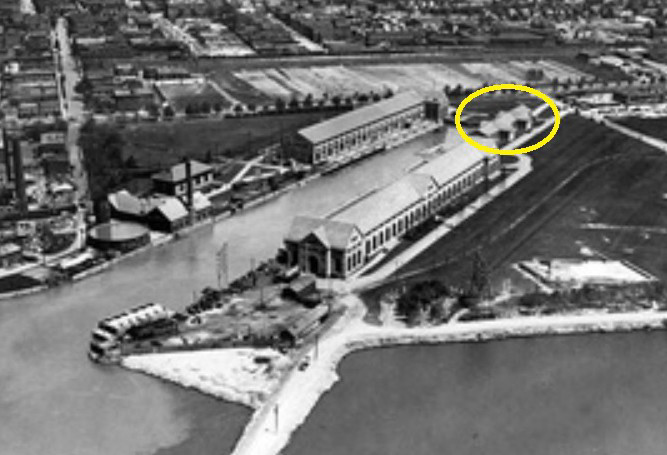
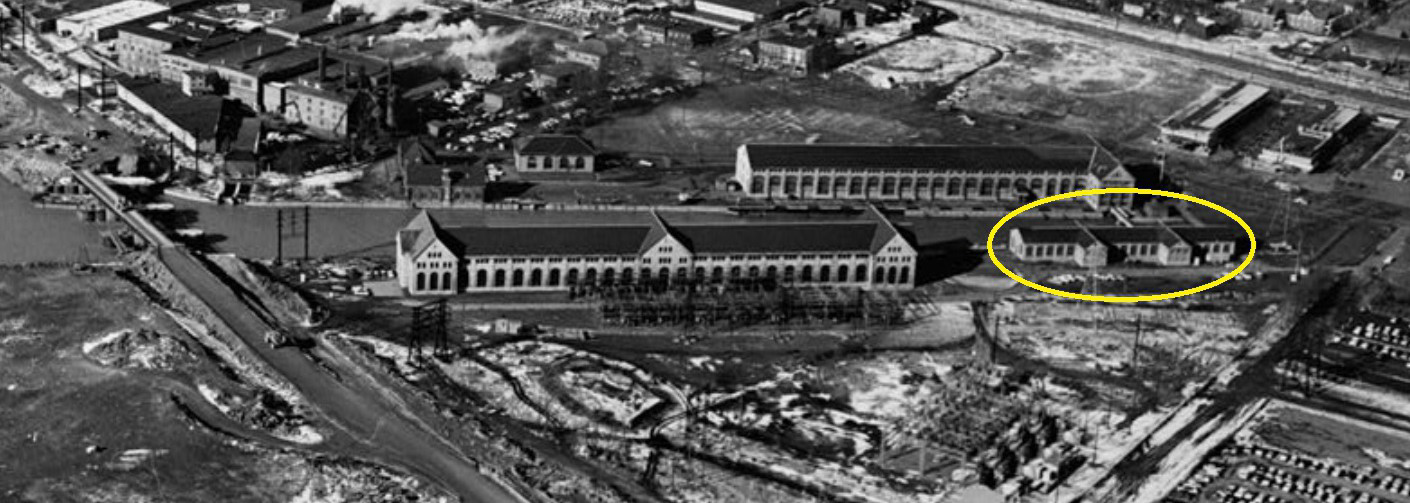
Note Power Houses #1 and Power House #2 on the sides of the hydro canal, with the Transformer House just beyond the end of the canal.
Adams Power Plant, Transformer House Circled In Yellow
The Transformer House can be seen today both from Buffalo Avenue at 15th Street and from the Robert Moses Parkway. Adjacent to the Parkway, on the river side, a section of the old hydro canal can also be seen. At the opposite end of the hydro canal, a section seems to have been repurposed for use in the Waste Water Treatment Plant, constructed on the adjacent property in the mid 1980’s. This can be seen in a more recent photograph of the Transformer House. The Adams tailrace tunnel has also been repurposed to discharge the effluent of Waste Water Treatment Plant into the lower Niagara River. It can be seen between the Maid of the Mist boat landing and the base of the Rainbow Bridge.
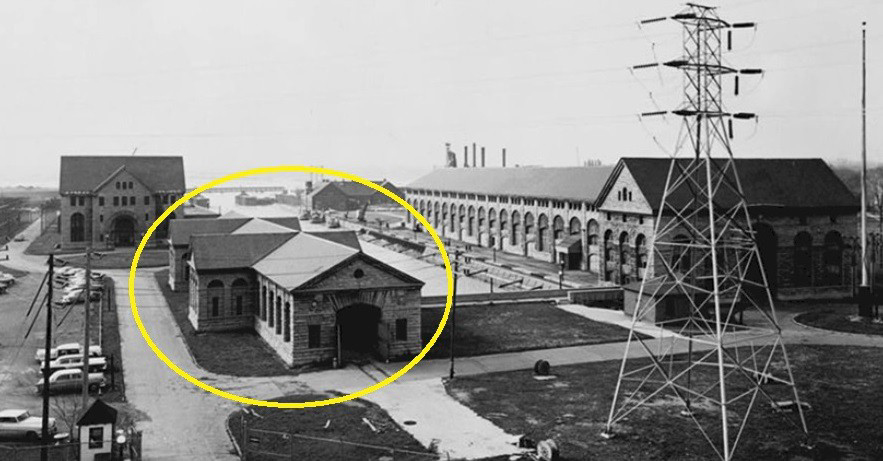
Adams Power Plant, Street View. Transformer House Center & Circled in Yellow Left rear: Power House #2 – Right rear: Power House #1

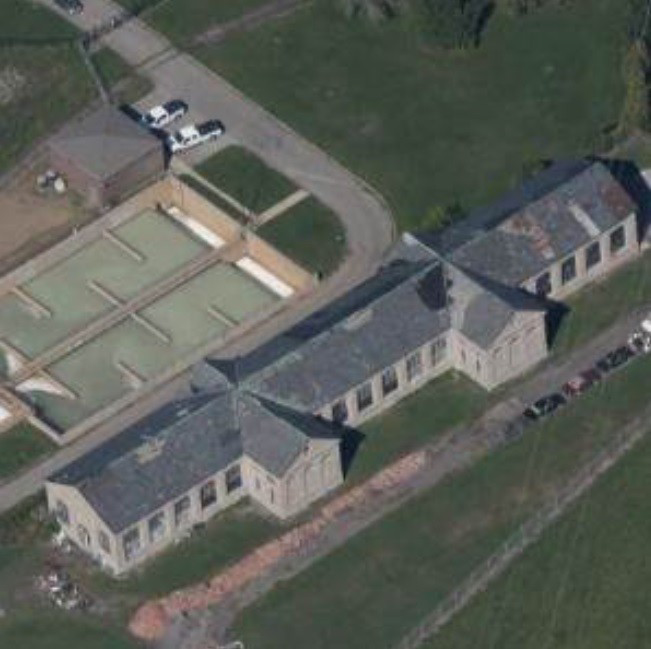
Some of the literature examined in this paper, incorrectly states that the generators were in the
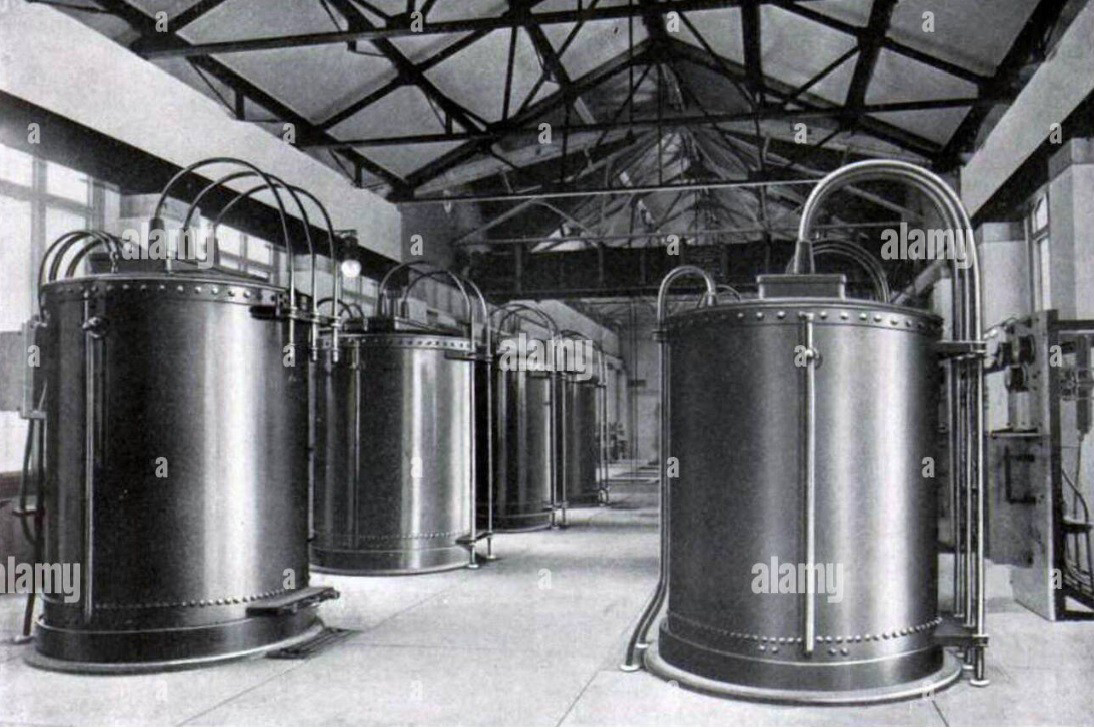
Left: Power House, Right: Transformer House Pre-1940
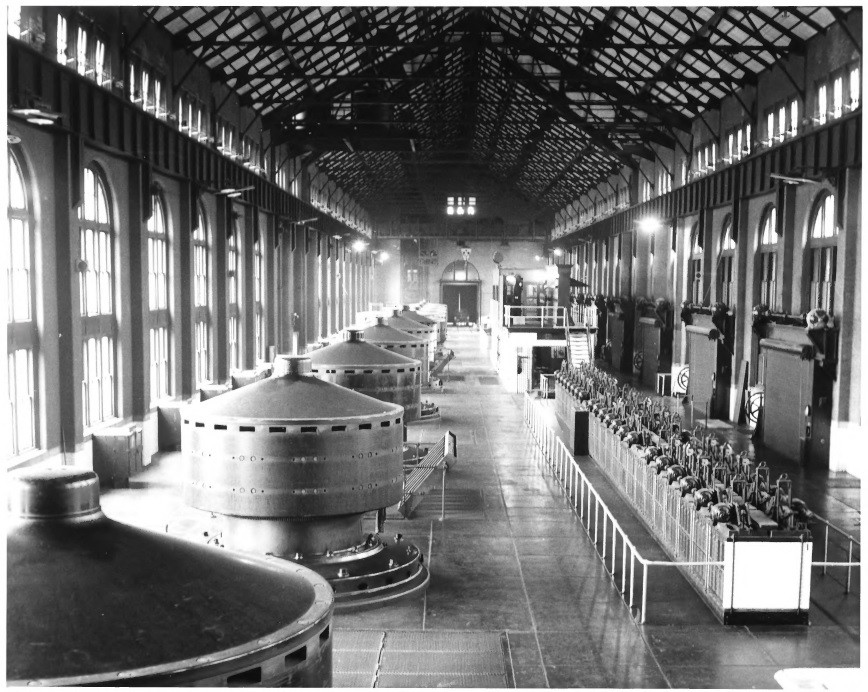
Transformer House. The two photographs below show the equipment installed in the buildings. Power Houses #1 and #2 each contained ten generators. The Transformer House contained ten transformers, configured as five Scott-T banks. Each Scott bank supported four generators and interfaced the 2- phase, 2,200 Volt generators to the 3-phase, 11,000 Volt distribution system.
Examination of the Literature
From Wikipedia, the most incorrect and often repeated information:
Adams Power Plant Transformer House
“The original Westinghouse generators remained in operation in the transformer house until the plant closed in 1961,[3] having been replaced by the Robert Moses Niagara Power Plant and the Lewiston Pump-Generating Plant.”
This is the single most provably false collection of information in the literature. As
explained later in this paper, it is false relative to the building (Transformer House), year
(1961), and relationship to the Robert Moses plant.
Reference cited in the quote above: [3] Christian, Ralph J.; James Gardner (September 9, 1978). “National Register of Historic Places Inventory-Nomination: Adams Power Plant Transformer House” (pdf). National Park Service. and Accompanying photos, exterior and interior, from 1978. (2.61 MB)
It appears that the party applying for National Register of Historic Place status, embellished the truth, by not just a little, but a lot. The application was successful and, since it has become a legal document, the false and conflicting information, began its propagation throughout the literature and is now dominate. The Adams Transformer House was added to the National Register of Historic Places in 1975 and designated a National Historic Landmark in 1983.
Note: Some references refer to the Transformer House as Power House #3. Adams had only Power Houses #1 and #2, plus the Transformer House, which served both Power Houses and contained only transformers, not generators.
Better, but still contradictory information:
NATIONAL REGISTER OF HISTORIC PLACES INVENTORY — NOMINATION FORM Adams Power Plant Transformer House – 1978
“Inside, the structure appears to have undergone little alteration except for the removal of its original transforming equipment. The brick-lined walls are an original feature as are portions of the floor which are constructed of stone blocks. Also believed to be original are the porcelain insulators for the “gateways” on the southeast side of the building and an overhead crane, currently utilized by the present tenant. Presently, Union Carbide uses the building to house three 1930s-era rotary converters to supply 25-cycle current to its electric furnaces. The Transformer House appears to be in very good condition and is well maintained.”
See the photo with no transformers and one of the rotary converters, a.k.a., frequency changers, below.) (This was true in the 1950s and at the time this application was made. The rotary converters were removed in 2003 and the building was sold. It is now used for storage.)
“The entire plant was completed in 1904 and officially named in 1927 after the Cataract president, Edward Dean Adams. The Westinghouse generators remained in operation until the plant closed in 1961.”
Provably false and inconsistent with the above statement in the same document and often repeated in the literature.
Note: A photograph of a running Adams Station generator has been seen in the literature with a 1958 date. However, the clothes worn by the employee in the photo are clearly more consistent with the early 1900s than 1958. Therefore, the date associated with this photo is also considered to be false. After the removal of the equipment, sometime around 1940, the Power Houses sat empty, until their destruction in the 1980’s.
The photograph below shows one of the 1930’s era frequency changers, a.k.a., rotary converters, installed in the Transformer House after the removal of the transformers. There were two such machines owned by Union Carbide and a third was added in the 1960s. Today, space in the Transformer House is rented out for storage.
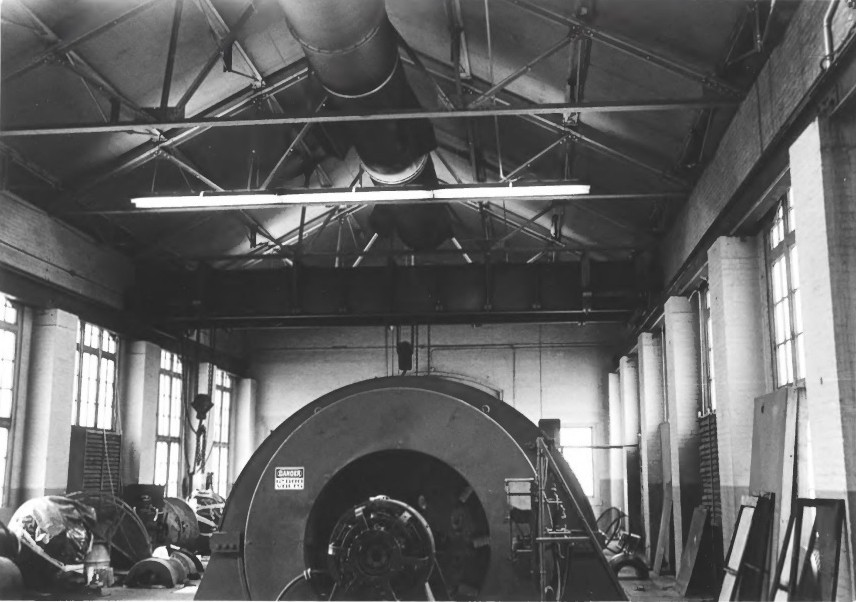
Transformer House with 60 Hz to 25 Hz Frequency Changer, a.k.a., Rotary Converter post-1940
Better and Including Information on WW-II
Reference: 25-Hz at Niagara Falls, end of an era on the Niagara Frontier, part 2 IEEE Power and Energy Magazine, 2008, Volume 6, Issues 1 and 2
NATIONAL REGISTER OF HISTORIC PLACES INVENTORY — NOMINATION FORM Adams Power Plant Transformer House – 1978
“The Edward Dean Adams Stations (figure omitted), which had been placed in reserve by 1924, were returned to service at the beginning of World War II when the increased demand for electric power resulted in an increase in the permissible water diversion. The Adams Stations and the rehabilitated portion of Schoellkopf Station 3A operated at high load factors until 30 September 1961 when they were shut down and their water allocation transferred to the Robert Moses Plant.”
This is one of the very few statements as to whether or not Adams Station operated during WW-II. While the above statement is correct regarding Schoellkopf Station 3-A, Adams Station was definitely not operating after WW-II or until 1961. Schoellkopf 3-A is the only power plant at Niagara Falls to shut down in 1961.
In this 2-part article, Thomas J. Blalock and Craig A. Woodworth give an excellent history of 25 Hz generation at Niagara Falls. 25 Hz was used heavily by industry in both the U.S. and Canada, but was used domestically only in Canada. Most Canadian homes were converted to 60 Hz in the 1950’s, although one community was still on 25 Hz at the time of the collapse of the 60 Hz grid and resulting blackout in 1965.
Best known information on the closing date:
Reference: 25-Hz at Niagara Falls, end of an era on the Niagara Frontier, part 2 IEEE Power and Energy Magazine, 2008, Volume 6, Issues 1 and 2 http://ieeexplore.ieee.org/stamp/stamp.jsp?arnumber=4412948
“Then, in 1921, construction began on adjacent [to Schoellkopf 3-B, not Adams] Schoellkopf Station No. 3-C. This was completed in 1924 and contained three 25-Hz generators with a total capacity of 210,000 hp. Because the Hydraulic Canal could not be enlarged further, the water for this new station was supplied via a new pressure tunnel running along nearly the same route as the Hydraulic Canal above it. Station No. 3-C then utilized the water allotment for the Adams Stations, which were shut down and placed in reserve. The Schoellkopf Stations in the gorge were more efficient due to their greater available hydraulic head of 210 ft (64 m) as compared to only 135 ft (41 m) for the Adams Stations. This difference was due to the slope of the tailrace tunnel for the Adams Stations.”
True, making 1924 the most believable date.
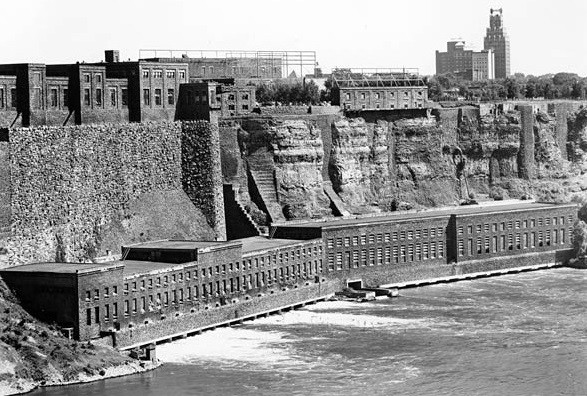
Left to right: Schoellkopf 3A (1914), 3B (1920), and 3C (1924) Schoellkopf 3C Replaced Adams in 1924 and was destroyed in 1956
For a power plant, the elevation difference between the water source and the turbine, called “head,” determines the efficiency. Any elevation difference below the turbine is wasted. The 56% increase in head between Adams and Schoellkopf was possible because the 1.2 mile long Adams discharge tunnel, with its 80 foot drop, was eliminated, now putting the 80 feet above the turbine. A similar increase in efficiency is gain by building the Sir Adam Beck and Robert Moses generating plant further downriver, beyond another 80 ft drop created by the rapids between the falls and those facilities.
Supporting Legal Document
The following photo copy of a legal document contains a court decision restricting the operation of Adams Station, which ceased in 1924 with the start-up of Schoellkopf Station 3-C, to standby status. This May 14, 1937 decision was made my the Supreme Court of the State of new York, County of Albany in the case of the Water Power and Control Commission against the Niagara Falls Power Company. This document would lead one to believe that the generators were present and idle at Adams Station in 1937, but most likely removed shortly thereafter.
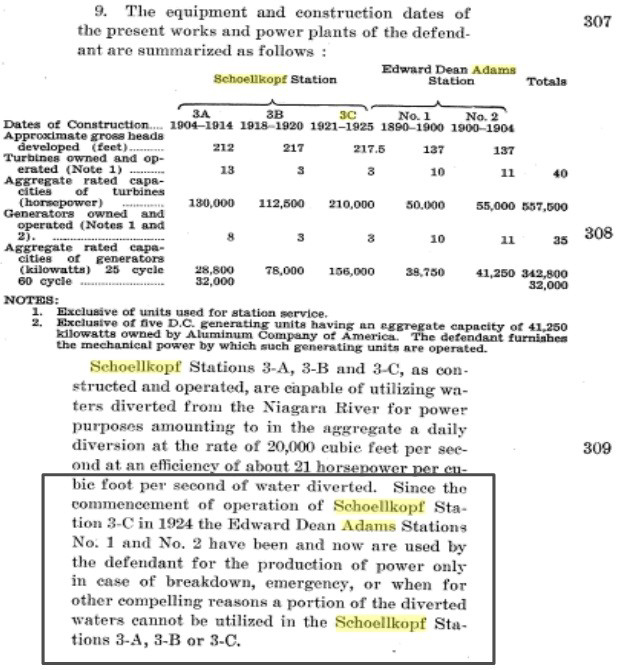
1937 Legal Decision Regarding the Shutdown of Adams Station
A time estimate for the removal and salvage of the Adams Station equipment has not been found in the literature, but is believed to be between 1937 and mid-1940s, based on the other evidence. According to one source Adams Station was reactivated during the WW-II relaxation of water restrictions, which began in 1941. (Reference: 25-Hz at Niagara Falls, end of an era on the Niagara Frontier, part 2) It remains unclear whether or not this the case. This same IEEE paper is the only known source stating that Adams Station was ever put back into operation. In the same paragraph of that paper, the authors state that Adams Station continued to operate until 30 September 1961, which is known to be false. The rotary frequency converters, not generators, did operate during this period, which may be what the authors of this source are referring to. The rotary frequency converters at Adams were removed in 2003.
Note: A shut-down date of 1916 has also been seen in a single document, with the words; “after more efficient generating stations closer to the falls came on line.” This date would be consistent with Rankine Station, Toronto Power Station, and/or Ontario Power Station, all in Canada, or coming on line just prior to this time as those more efficient 25 Hz stations. (Schoellkopf 3-B and 3-C, both generating 25 Hz, came on line in 1918 and 1924, respectively. Schoellkopf 3-A came on line in 1914 and generated mostly and, later, only 60 Hz power.) In actuality, It was Schoellkopf 3-C that was given Adams Stations water allocation and, therefore, replaced Adams Station.
Note: Rankine Station, the last 25 Hz generating station, shut down in 2006 and the 25 Hz grid ceased to exist in 2008
Conclusions
Why I believe the 1961 date and other information in the Wikipedia article to be incorrect and 1924 to be the correct date:
- The generators were never and could never have been located in in the transformer house, as stated in some references, because:
- The Transformer House is not adjacent to the hydro canal and has no source of water.
- The Transformer House did not sit over a deep pit, as did Power Houses #1 and #2, which were of a "deep pit" design, with the turbine at the bottom of the pit.
- The Transformer House did not have access to the tailrace tunnel into which to discharge water. The tunnel served only Power Houses #1 and #2.
- If the generators were in the transformer house, where would the Scott-T transformer banks to interface the 2-phase, 2,200 volt generators to the 3-phase, 11,000 volt distribution system be located? (There were a pair/bank of transformers for every four generators, five banks, ten transformers in all. The distribution voltage was later increased to 22,000 volts.)
- No water exited the Adams tailrace tunnel from my earliest memory (late 1940s), until the tunnel was reused by the city's new waste water treatment plant in the mid 1980s. This should be taken as proof that Adams was not reactivated after the 1956 collapse of Schoellkopf. The tailrace tunnel and oddly green colored waste water discharge are clearly visible from the Canadian side of the river, located between the Maid of the Mist boat dock and the base of the Rainbow Bridge.
- Adams was too inefficient due to the 80 ft elevation sacrificed in order to obtain the required slope of the long tailrace/discharge tunnel and its water allotment was reallocated to the new Schoellkopf 3-C plant in 1924. (My father operated the Schoellkopf 3-A, 3-B and 3-C generators in the early and mid 1950s.)
- By the 1950s and perhaps in the late 1930s or 1940s, the transformer house no longer contained the transformers needed to interface the 2-phase, generators to the 3-phase distribution system. Instead, it housed two and later three 1930s-era 60 Hz to 25 Hz rotary converters, owned by Union Carbide and operated by Niagara Mohawk. They supplied 25 Hz “Schoellkopf replacement power” to Union Carbide's electric metallurgy furnaces and carbide production. See the above photo of the Transformer House and one converter. There were two converters in the Transformer House through the 1950's and a third was added at a later date. Without the transformers, the generators would be inoperable.
- In the 1950s, Adams was an unstaffed distribution substation, serviced by the dispatch of a truck-based mobile "Traveling Operator," one of whom was my father. If Adam's generators were operating, the plant would have to have been staffed 24/7. (The rotary converters did not need full-time operators and the tasks of putting them on line and taking them off line were handled by the Niagara Mohawk Traveling Operator.)
- Even after the Schoellkopf disaster of June 7, 1956, Adams was not reactivated. The lost 25 Hz capacity was replaced by output from Sir Adam Beck #1, Rankine Station, Toronto Power Station, Ontario Power Station, all in Canada, and the coal fired Huntley steam generating station, in Tonawanda, NY. Adams Station was not listed. The generating equipment at Adams certainly was removed and salvaged by this time, most likely during the 1940s.
- Note: A Niagara Mohawk employee publication does mention some of the 25 Hz load being picked up by Adams. However, this may be by the 60 Hz to 25 Hz rotary converters installed in the transformer house, as no water could be seen coming out of the Adams tailrace/discharge tunnel, even after this disaster and the loss of so much 25 Hz generating capacity. The third rotary 60 Hz to 25 Hz rotary converter was installed around this time.
- Niagara Mohawk did not have operators trained and ready to operate the Adams Station generators, even if they would have been operational. This is due to union and pay-scale restrictions. Very few employees would even understand how to manually operate a station this old and none, including my father, had experience with operating the Adams Station generators.
- In the Spring of 1958, several Niagara Mohawk employees met at Adams to track a bear, discovered by my father, that had gained access to the facility. It was tracked through the snow into, but not out of, one of the now-empty Power Houses. It was assumed that the bear had fallen down into the wheel pit through one of the shaft openings, where the generators once sat. Obviously, the Adams Power Houses #1 and #2 were totally empty and unstaffed at this time.
- The 25 Hz generating capacity of Adams could not have been replaced at any time by the 60 Hz output from the Robert Moses or Lewiston Pump-Generating Power Plant, as stated in some references. With the exception of several rotary 25-to-60 Hz and 60-to-25 Hz converters, the 25 Hz and 60 Hz generation and distribution were totally independent grids. 25 Hz and 60 Hz distribution substations were often collocated in the same facility and operated by the same personnel, but were functionally separate. Rotary converters were located at Adams Station in Niagara Falls, Lockport, Gardenville, Huntley in Tonawanda, and Sir Adam Beck in Canada.
- The Schoellkopf 3-A plant's eleven repaired 60 Hz generators were the only generators in the region to be shut down when the 60 Hz Robert Moses Niagara Power Plant came on line in 1961 and took over Schoellkopf's water rights. 25 Hz generation in the area was unaffected by this transition.
About the author
My father, Roland Stell, operated the Schoellkopf generators, 3-C in particular, until transferring to the operations/distribution side of the business, just before the June 7, 1956 collapse. By age 11, he had taken me into the Schoellkopf facility several times, both privately and as part of tours, some of which he arranged. Growing up in this environment, I became an electronics engineer and math teacher.
My father then worked his way up through the ranks to the position of District Operator, responsible for the distribution of all power in the local area by Niagara Mohawk. As part of that process, he spent several years as a Traveling Operator, doing whatever was necessary at all unstaffed facilities, including Adams Station. As District Operator, he would direct the Traveling Operators activities at those facilities. Except for the three rotary converters, Adams Station was nothing more than a distribution substation from the late 1950s until his retirement. I have never been in Adams Station, because he felt that there was nothing of interest left to see.
I also had the advantage of being in high school during the construction of the Robert Moses plant. When it was completed and on-line, my father arranged a private tour of the Robert Moses facility that the public would never be allowed to see. I have been inside the big, 240,000 HP, generators, when idle, and have stood on a platform between a turbine and its generator, while running.
In my opinion, Adams Station served as a feasibility study, learning platform, experimental prototype, and, most of all, an capital investment magnet. As such, its importance can not be overstated. However, like all ground breaking endeavors of this type, its short life of 29 years is not unusual. Given its technical and historical significance, an overstated life of more than twice that amount is also not surprising. Some of the lessons learned at Adams Station are:
- When built like a permanent magnet motor, spinning the lower current field winding is better. This resulted in the exterior spinning mushroom cap design, which is unique to 15 of the Adams Station generators. The last five Adams Station generators and all later generators are simply built in-side-out, putting the field winding on the interior rotor.
- The new 3-phase AC system is superior to both DC and 2-phase AC systems for transmission. (High voltage, long distance DC transmission became possible only in the past few decades.)
- Generating stations should be built closer to the falls to eliminate the efficiency and elevation difference lost in the tailrace/discharge tunnel and increase the usable head. (The newer plants are built further down river, beyond the rapids, for even greater efficiency and elevation or head.)
- Generators should be located down near the turbines, eliminating the weight and instability of the long shafts of the deep pit design. Rankine Station and Toronto Power Station were the last of the three deep pit designs at Niagara.
- 25 Hz is too low a frequency for domestic use, as lights blinked noticeably, which I clearly remember. 25 Hz magnetics, transformers and motors, are also heavier than 60 Hz magnetics.
One of the old plants above the Horseshoe Falls on the Canadian side, Rankine Station is now a museum, because of its location at the edge of the tourist area and architectural beauty. Fortunately, the generators of Rankine Station have been retained and the Niagara Parks Commission has turned the facility into a museum. Other historical photographs can be found on the U.S. In the Power Vista at the Robert Moses Generating Station.
There was interest in such a museum at the Adams Station Transformer House, which is why the Transformer House National Historical Site application, with its exaggerations, was made. However, I do not believe that this would be a good location for the following reasons:
- It is 15 city blocks up-river, from the tourist area near the falls and in an industrial area.
- Everything of historical significance, except the shell of the Transformer House, has been demolished.
- The adjacent property is now home to the city's new sewage treatment plant, making a visit rather unpleasant. The effluent from the new treatment plant is released into the lower Niagara River through the old Adams tailrace tunnel, located between the Maid of Mist dock and foot of the Rainbow Bridge.
Bonus Material: Notes and Discrepancies in the Literature
During the extensive research of the public and non-public literature required to prepare this paper, a number of other discrepancies were discovered. These discrepancies are presented below, without source citations.
U.S.: John Dean Adams
Reactivation: It is also unclear if this facility was reactivated during WW-II. Adams’ generators were definitely not reactivated after the 1956 collapse of Schoellkopf and the loss of its 25 Hz production.
Number of generators: Most documents mention 10 generators in each of the two Power Houses and 5 Scott-T banks in the Transformer House, each of which serves 4 generators. However, one document states that there were 11 generators in Power House #2. What Scott-T bank would have supported it and was it a full-size, 5,000 Hp machine or a smaller machine for “station power”? (A “black restart” of Adams after connection Power House #2 to the tailrace tunnel, required diesel generated power from Buffalo, which suggest the lack of a “station power” machine.)
U.S.: Schoellkopf 3-A
Number of generators: Sources list between 13 and 17 generators. One document that states that two of those generators are small, 1,000 Hp machines for “Station power” or “House power.” (These small,manually operated, machines allow the facility to perform a “black start,” without requiring power from the grid.) 14 is the number I remember, although my father did speak of “house Power” machines.
Generator capacity: Capacities of both 9,000 Hp and 10,000 Hp exist in the literature for the Schoellkopf generators. 9,000 Hp is the number I remember.
Frequency: While most sources state that all of Schoellkopf 3-A’s generators operated at 60 Hz at the time of collapse on June 7, 1956, one source states that only 9 machines generated 60 Hz power and 4 machines generated 25 Hz power. My father, who operated machines through out the Schoellkopf plant also told me that 3-A was entirely 60 Hz, while the three machines of 3-B and three machines of 3-C were 25 Hz.
U.S.: Schoellkopf 3-B
Generator capacity: Capacities ranging from 32,500 Hp to 37,500 Hp exist in the literature for the Schoellkopf generators. 34,500 Hp is the number I remember.
Canada: Ontario Power (below the Horseshoe Falls)
Total capacity: A source states the the 15 machines of this power plant produced a total of 205,000 Hp, which equates to 13,667 Hp per machine average. However, it is also stated in the literature that the early machines installed were 10,000 Hp and the last few were 12,500 Hp. This makes an average of 13,667 Hp impossible.
Reactivation and shutdown: These dates are also unclear. I do remember it being reactivated after the 1956 collapse of Schoellkopf and the loss of its 25 Hz production, with a shutdown in 1987. The operational status of this facility was clearly visible from the Maid of the Mist boat ride and the Goat Island State Park on the U.S. side.
Canada: Toronto Power (above the Horseshoe Falls)
Total capacity: A source states the the 11 machines of this power plant produced a total of 157,000 Hp, which equates to 14,273 Hp per machine average. However, it is also stated in the literature that the early machines installed were 10,000 Hp and the last few were 12,500 Hp. This makes an average of 13,667 Hp impossible. Another source states that both Ontario Power and Toronto Power each produced 100,000 KW of electricity, which equates to around 134,000 Hp.
Miscellaneous Notes
25 Hz: 25 Hz was used extensively by industry in both the U.S. and Canada, but was used domestically only in Canada. I remember relatives in Saint Catherine’s, Ontario converting to 60 Hz in the mid1950s and Fort Erie, Ontario was still on 25 Hz at the time of the 1965 collapse of the 60 Hz power grid. 25 Hz was provided at Niagara Falls by Adams Station, Schoellkopf 3-B, Schoellkopf 3-C, Rankine Station, Toronto Power, Ontario Power, and rotary converters at Adams Station, and Sir Adam Beck.
60 Hz: 60 Hz was provided at Niagara Falls by Schoellkopf 3-A, Sir Adam Beck, and later Robert Moses.
Start-up date: This is normally the date that the first generator of a power plant comes online. It typically takes 2 to 20 years to complete the construction and reach fully capacity. The start-up date is usually well defined and accurate, while the start of construction and completion dates are less frequently documented.
Shut-down date: This date is often not well defined and far less accurate. Generating stations nearing end of life will usually reduce output, go into standby mode, may or may not be reactivated briefly and finally salvaged. Therefore, the final shut-down and decommission dates are rough estimates at best. 1924 is the year that Adams Station went into standby mode, having its water allocation transferred the more efficient Schoellkopf 3-C facility.

